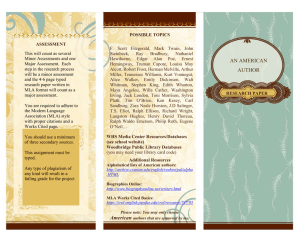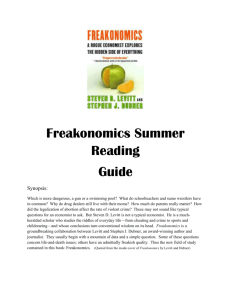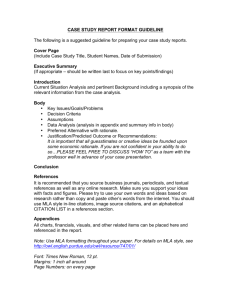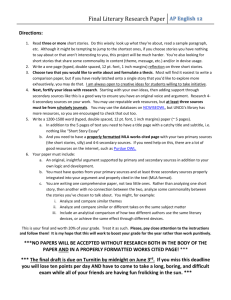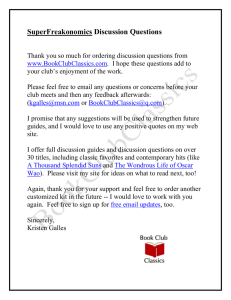On-Level English 12 Summer Reading Assignment 2 – Hamilton
advertisement
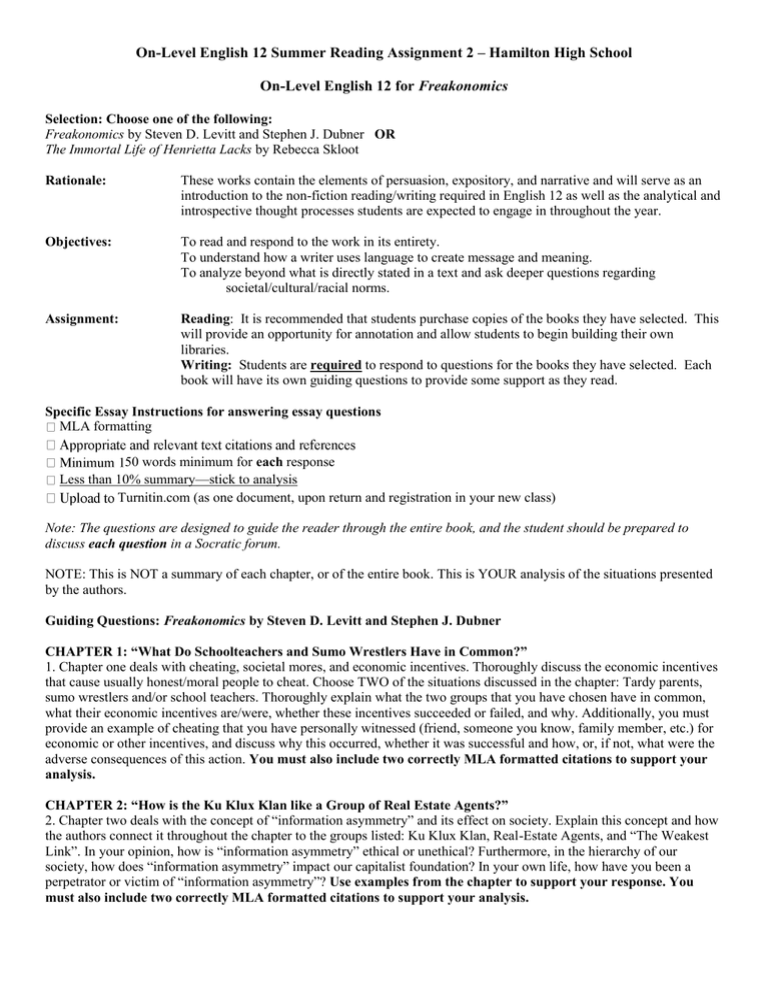
On-Level English 12 Summer Reading Assignment 2 – Hamilton High School On-Level English 12 for Freakonomics Selection: Choose one of the following: Freakonomics by Steven D. Levitt and Stephen J. Dubner OR The Immortal Life of Henrietta Lacks by Rebecca Skloot Rationale: These works contain the elements of persuasion, expository, and narrative and will serve as an introduction to the non-fiction reading/writing required in English 12 as well as the analytical and introspective thought processes students are expected to engage in throughout the year. Objectives: To read and respond to the work in its entirety. To understand how a writer uses language to create message and meaning. To analyze beyond what is directly stated in a text and ask deeper questions regarding societal/cultural/racial norms. Assignment: Reading: It is recommended that students purchase copies of the books they have selected. This will provide an opportunity for annotation and allow students to begin building their own libraries. Writing: Students are required to respond to questions for the books they have selected. Each book will have its own guiding questions to provide some support as they read. Specific Essay Instructions for answering essay questions MLA formatting 50 words minimum for each response Less than 10% summary—stick to analysis Turnitin.com (as one document, upon return and registration in your new class) Note: The questions are designed to guide the reader through the entire book, and the student should be prepared to discuss each question in a Socratic forum. NOTE: This is NOT a summary of each chapter, or of the entire book. This is YOUR analysis of the situations presented by the authors. Guiding Questions: Freakonomics by Steven D. Levitt and Stephen J. Dubner CHAPTER 1: “What Do Schoolteachers and Sumo Wrestlers Have in Common?” 1. Chapter one deals with cheating, societal mores, and economic incentives. Thoroughly discuss the economic incentives that cause usually honest/moral people to cheat. Choose TWO of the situations discussed in the chapter: Tardy parents, sumo wrestlers and/or school teachers. Thoroughly explain what the two groups that you have chosen have in common, what their economic incentives are/were, whether these incentives succeeded or failed, and why. Additionally, you must provide an example of cheating that you have personally witnessed (friend, someone you know, family member, etc.) for economic or other incentives, and discuss why this occurred, whether it was successful and how, or, if not, what were the adverse consequences of this action. You must also include two correctly MLA formatted citations to support your analysis. CHAPTER 2: “How is the Ku Klux Klan like a Group of Real Estate Agents?” 2. Chapter two deals with the concept of “information asymmetry” and its effect on society. Explain this concept and how the authors connect it throughout the chapter to the groups listed: Ku Klux Klan, Real-Estate Agents, and “The Weakest Link”. In your opinion, how is “information asymmetry” ethical or unethical? Furthermore, in the hierarchy of our society, how does “information asymmetry” impact our capitalist foundation? In your own life, how have you been a perpetrator or victim of “information asymmetry”? Use examples from the chapter to support your response. You must also include two correctly MLA formatted citations to support your analysis. CHAPTER 3: “Why Do Drug Dealers Still Live with Their Moms?” 3. In Chapter three, Freakonomics tackles the subject of conventional wisdom and, in providing information from a study about drug dealers, argues that often the conventional wisdom is simply not true. The chapter in turn dispels much of our knowledge regarding the drug trade. Using AT LEAST TWO examples from the text, explain how J.T. and the Black Disciples are similar to a franchise like McDonald's? How is the drug trade similar to the hierarchy in the American business world? Explain how incentives differ for the upper management of a drug ring compared to the lower "foot soldiers?" CHAPTER 4: “Where Have All the Criminals Gone?” 4. Chapter 4 deals with the lowering of the crime rate in America, in all categories of crime, during the late 1970s and early 1980s. Various diverse theories have been proposed as to the drop in the crime rate, with numerous elected and judicial officials claiming credit due to their actions and/or plans for reducing crime. The authors indicate a completely different reason for the crime rate being lowered. Their proposal is controversial, raised many eyebrows, and is often rejected by other economists and officials. Explain thoroughly what the authors’ theory is for the lowering of the crime rate, provide statistics from the chapter to support their argument, and then thoroughly analyze their theory: Do you agree or disagree with their idea? Why or why not? You must also include two correctly MLA formatted citations to support your analysis. CHAPTER 5: “What Makes a Perfect Parent?” 5. In Chapter 5, the authors argue that research refutes the conventional wisdom held by most parents that what a parent makes a difference in whether a child succeeds. When looking at statistical data over a period of time, what does “correlation” mean? How is it different from “causation”? Explain an example from your life where you have observed “correlation” being confused with “causation.” Describe, in general terms, the Early Childhood Longitudinal Study (ECLS)? Who conducted it, who was the target of the study, and what was the purpose of the study? According to the data developed from this study, what is more important regarding a child’s success on standardized tests: What a parent does for a child or what a parent is? In your opinion, what might be an explanation for such a strange conclusion? Do you believe this conclusion accurately expresses “causation”? Support your opinion with textual evidence, and provide at least one example from this chapter to support your stated opinion. Chapter 6: “A Roshanda by Any Other Name” 6. Chapter six covers the first thing a parent ever does for his or her children; naming them. The authors’ major question is if names (as in the instances of Winner, Loser, and Temptress) are merely a curiosity or if a name has something larger to say about names and culture. A large study was conducted using California birth records, and these records showed that there was a tight correlation between how “black” or “white” a name sounds and how that person did in life. What do the authors have to say about this correlation? Do you agree? Look at the notes on pages 289-293 for more statistics. Fully explain the authors’ theory and use examples from the book to support their argument. Do you agree or disagree with their idea? Why or why not? Does your name or your parents’ names appear on any of the list, either in the chapter or in the notes at the back of the book? If so, do you think it means anything? You must include two correctly MLA formatted citations to support your analysis.
